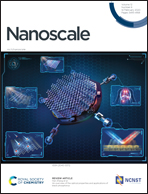Zn doped MAPbBr3 single crystal with advanced structural and optical stability achieved by strain compensation†
Abstract
A mechanistic understanding of perovskite degradation is one of the most urgent issues to push perovskite devices toward commercial applications. Surface coverings will lower the electrical injection and light extraction efficiency of perovskites. Therefore, structural modification of Zn doped perovskites has been proposed herein. The Zn doping will induce local lattice strain due to smaller ionic radius. It is interesting that the lattice structure at atomic resolution has been observed directly through cryo-TEM. Under light illumination, the photostriction will compensate for the local lattice strain, which leads to structural stability as evidence suggests no phase transition in temperature ranges of the temperature-dependent photoluminescence spectra. In addition, MPZB also shows less than 3% decrease in PL intensity after 60 days. This is because the Zn doping induced the lowest defect density in the MPZB SC (density of trap-states ntrp = 6.33 × 108 cm−3), which has been confirmed by the high performance of the photodetector. Such strain compensation is expected to fundamentally improve the stability of photoelectric devices.

- This article is part of the themed collection: 2020 Nanoscale HOT Article Collection


 Please wait while we load your content...
Please wait while we load your content...